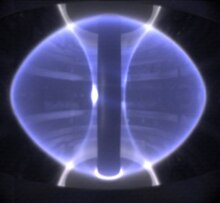Mega-Amps Spherical Tokamak
The Mega-Ampere Spherical Tokamak ( MAST ) is a research facility for fusion experiments at the British Science Center Culham . The experiments carried out as part of an EU-funded project have been running since 1999. Precursors were the experiments on the Small Tight Aspect Ratio Tokamak (START) from 1991 to 1998. MAST is currently being upgraded.
The compact "spherical" tokamaks differ from normal tokamaks (see ITER ) in that they have a larger ratio of the small to the large radius of the torus . This is achieved through a slimmer solenoid and a common central conductor for the toroidal field coils.
The compact geometry with a D-shaped plasma cross-section leads to a more stable magnetic confinement , which is expressed in a higher plasma beta . Achieved = 40%, while 5% is common with classic tokamaks. The coil system can be correspondingly smaller and cheaper. The compact geometry also increases the load on the wall. As part of the upgrade, MAST is getting a new divertor in which the particles branched off from the edge of the plasma travel longer to the wall and give off a larger part of their energy in the form of thermal radiation, i.e. less concentrated.
The main objectives of the MAST experiments are
- conducting studies to gain a better understanding of tokamak facilities and improve ITER design
- the investigation of the possibilities of a spherical tokamak system for energy generation
Individual evidence
- ↑ CCFE: MAST upgrade , 2012.
- ^ Daniel Clery: Feature: The new shape of fusion . Science News, May 21, 2015.
Web links
- Homepage of MAST (English)
Coordinates: 51 ° 39 '25.7 " N , 1 ° 13' 50" W.

